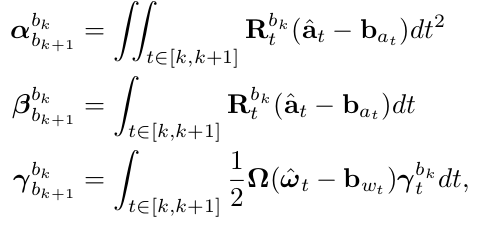VINS(七)estimator_node 数据对齐 imu预积分 vision
首先通过vins_estimator mode监听几个Topic(频率2000Hz),将imu数据,feature数据,raw_image数据(用于回环检测)通过各自的回调函数封装起来
ros::Subscriber sub_imu = n.subscribe(IMU_TOPIC, , imu_callback, ros::TransportHints().tcpNoDelay());
ros::Subscriber sub_image = n.subscribe("/feature_tracker/feature", , feature_callback);
ros::Subscriber sub_raw_image = n.subscribe(IMAGE_TOPIC, , raw_image_callback);
imu_buf.push(imu_msg);
feature_buf.push(feature_msg);
image_buf.push(make_pair(img_ptr->image, img_msg->header.stamp.toSec()));
然后开启处理measurement的线程
std::thread measurement_process{process};
process()函数中,首先将获取的传感器数据imu_buf feature_buf对齐,注意这里只保证了相邻的feature数据之间有完整的imu数据,并不能保证imu和feature数据的精确对齐
// multiple IMU measurements and only one vision(features) measurements
std::vector<std::pair<std::vector<sensor_msgs::ImuConstPtr>, sensor_msgs::PointCloudConstPtr>>
getMeasurements()
{
std::vector<std::pair<std::vector<sensor_msgs::ImuConstPtr>, sensor_msgs::PointCloudConstPtr>> measurements; while (true)
{
if (imu_buf.empty() || feature_buf.empty())
return measurements; // synchronize, if strictly synchronize, should change to ">="
// end up with : imu_buf.front()->header.stamp < feature_buf.front()->header.stamp // 1. should have overlap
if (!(imu_buf.back()->header.stamp > feature_buf.front()->header.stamp))
{
ROS_WARN("wait for imu, only should happen at the beginning");
sum_of_wait++;
return measurements;
} // 2. should have complete imu measurements between two feature_buf msg
if (!(imu_buf.front()->header.stamp < feature_buf.front()->header.stamp))
{
ROS_WARN("throw img, only should happen at the beginning");
feature_buf.pop();
continue;
} sensor_msgs::PointCloudConstPtr img_msg = feature_buf.front();
feature_buf.pop(); std::vector<sensor_msgs::ImuConstPtr> IMUs;
while (imu_buf.front()->header.stamp <= img_msg->header.stamp)
{
IMUs.emplace_back(imu_buf.front());
imu_buf.pop();
} measurements.emplace_back(IMUs, img_msg);
}
return measurements;
}
接下来进入对measurements数据的处理:
处理imu数据的接口函数是processIMU()
处理vision数据的借口函数是processImage()
(一)IMU
1. 核心API:
midPointIntegration(_dt, acc_0, gyr_0, _acc_1, _gyr_1, delta_p, delta_q, delta_v,
linearized_ba, linearized_bg,
result_delta_p, result_delta_q, result_delta_v,
result_linearized_ba, result_linearized_bg, );
其中,0代表上次测量值,1代表当前测量值,delta_p,delta_q,delta_v代表相对预积分初始参考系的位移,旋转四元数,以及速度(例如,从k帧预积分到k+1帧,则参考系是k帧的imu坐标系)
对应实现的是公式:

相应的离散实现使用Euler,Mid-point,或者龙格库塔(RK4)数值积分方法。
Euler方法如下:

2. 求状态向量对bias的Jacobian,当bias变化较小时,使用Jacobian去更新状态;否则需要以当前imu为参考系,重新预积分,对应repropagation()。同时,需要计算error state model中误差传播方程的系数矩阵F和V:
// pre-integration
// time interval of two imu; last and current imu measurements; p,q,v relate to local frame; ba and bg; propagated p,q,v,ba,bg;
// whether to update Jacobian and calculate F,V
void midPointIntegration(double _dt,
const Eigen::Vector3d &_acc_0, const Eigen::Vector3d &_gyr_0,
const Eigen::Vector3d &_acc_1, const Eigen::Vector3d &_gyr_1,
const Eigen::Vector3d &delta_p, const Eigen::Quaterniond &delta_q, const Eigen::Vector3d &delta_v,
const Eigen::Vector3d &linearized_ba, const Eigen::Vector3d &linearized_bg,
Eigen::Vector3d &result_delta_p, Eigen::Quaterniond &result_delta_q, Eigen::Vector3d &result_delta_v,
Eigen::Vector3d &result_linearized_ba, Eigen::Vector3d &result_linearized_bg, bool update_jacobian)
{
//ROS_INFO("midpoint integration");
// mid-point integration with bias = 0
Vector3d un_acc_0 = delta_q * (_acc_0 - linearized_ba);
Vector3d un_gyr = 0.5 * (_gyr_0 + _gyr_1) - linearized_bg;
result_delta_q = delta_q * Quaterniond(, un_gyr() * _dt / , un_gyr() * _dt / , un_gyr() * _dt / );
Vector3d un_acc_1 = result_delta_q * (_acc_1 - linearized_ba);
Vector3d un_acc = 0.5 * (un_acc_0 + un_acc_1);
result_delta_p = delta_p + delta_v * _dt + 0.5 * un_acc * _dt * _dt;
result_delta_v = delta_v + un_acc * _dt;
// ba and bg donot change
result_linearized_ba = linearized_ba;
result_linearized_bg = linearized_bg; // jacobian to bias, used when the bias changes slightly and no need of repropagation
if(update_jacobian)
{
// same as un_gyr, gyrometer reference to the local frame bk
Vector3d w_x = 0.5 * (_gyr_0 + _gyr_1) - linearized_bg; // last acceleration measurement
Vector3d a_0_x = _acc_0 - linearized_ba;
// current acceleration measurement
Vector3d a_1_x = _acc_1 - linearized_ba; // used for cross-product
// pay attention to derivation of matrix product
Matrix3d R_w_x, R_a_0_x, R_a_1_x; R_w_x<<, -w_x(), w_x(),
w_x(), , -w_x(),
-w_x(), w_x(), ;
R_a_0_x<<, -a_0_x(), a_0_x(),
a_0_x(), , -a_0_x(),
-a_0_x(), a_0_x(), ;
R_a_1_x<<, -a_1_x(), a_1_x(),
a_1_x(), , -a_1_x(),
-a_1_x(), a_1_x(), ; // error state model
// should use discrete format and mid-point approximation
MatrixXd F = MatrixXd::Zero(, );
F.block<, >(, ) = Matrix3d::Identity();
F.block<, >(, ) = -0.25 * delta_q.toRotationMatrix() * R_a_0_x * _dt * _dt +
-0.25 * result_delta_q.toRotationMatrix() * R_a_1_x * (Matrix3d::Identity() - R_w_x * _dt) * _dt * _dt;
F.block<, >(, ) = MatrixXd::Identity(,) * _dt;
F.block<, >(, ) = -0.25 * (delta_q.toRotationMatrix() + result_delta_q.toRotationMatrix()) * _dt * _dt;
F.block<, >(, ) = -0.25 * result_delta_q.toRotationMatrix() * R_a_1_x * _dt * _dt * -_dt;
F.block<, >(, ) = Matrix3d::Identity() - R_w_x * _dt;
F.block<, >(, ) = -1.0 * MatrixXd::Identity(,) * _dt;
F.block<, >(, ) = -0.5 * delta_q.toRotationMatrix() * R_a_0_x * _dt +
-0.5 * result_delta_q.toRotationMatrix() * R_a_1_x * (Matrix3d::Identity() - R_w_x * _dt) * _dt;
F.block<, >(, ) = Matrix3d::Identity();
F.block<, >(, ) = -0.5 * (delta_q.toRotationMatrix() + result_delta_q.toRotationMatrix()) * _dt;
F.block<, >(, ) = -0.5 * result_delta_q.toRotationMatrix() * R_a_1_x * _dt * -_dt;
F.block<, >(, ) = Matrix3d::Identity();
F.block<, >(, ) = Matrix3d::Identity(); MatrixXd V = MatrixXd::Zero(,);
V.block<, >(, ) = 0.25 * delta_q.toRotationMatrix() * _dt * _dt;
V.block<, >(, ) = 0.25 * -result_delta_q.toRotationMatrix() * R_a_1_x * _dt * _dt * 0.5 * _dt;
V.block<, >(, ) = 0.25 * result_delta_q.toRotationMatrix() * _dt * _dt;
V.block<, >(, ) = V.block<, >(, );
V.block<, >(, ) = 0.5 * MatrixXd::Identity(,) * _dt;
V.block<, >(, ) = 0.5 * MatrixXd::Identity(,) * _dt;
V.block<, >(, ) = 0.5 * delta_q.toRotationMatrix() * _dt;
V.block<, >(, ) = 0.5 * -result_delta_q.toRotationMatrix() * R_a_1_x * _dt * 0.5 * _dt;
V.block<, >(, ) = 0.5 * result_delta_q.toRotationMatrix() * _dt;
V.block<, >(, ) = V.block<, >(, );
V.block<, >(, ) = MatrixXd::Identity(,) * _dt;
V.block<, >(, ) = MatrixXd::Identity(,) * _dt; //step_jacobian = F;
//step_V = V;
jacobian = F * jacobian;
covariance = F * covariance * F.transpose() + V * noise * V.transpose();
}
}
(二)Vision
首先判断该帧是否关键帧:
if (f_manager.addFeatureCheckParallax(frame_count, image))
marginalization_flag = MARGIN_OLD;
else
marginalization_flag = MARGIN_SECOND_NEW;
关键帧的判断依据是rotation-compensated过后的parallax足够大,并且tracking上的feature足够多;关键帧会保留在当前Sliding Window中,marginalize掉Sliding Window中最旧的状态,如果是非关键帧则优先marginalize掉。
1. 标定外参旋转矩阵
initial_ex_rotation.CalibrationExRotation(corres, pre_integrations[frame_count]->delta_q, calib_ric)
其中
pre_integrations[frame_count]->delta_q
是使用imu pre-integration获取的旋转矩阵,会和视觉跟踪求解fundamentalMatrix分解后获得的旋转矩阵构建约束方程,从而标定出外参旋转矩阵。
2. 线性初始化
if (solver_flag == INITIAL)
{
if (frame_count == WINDOW_SIZE)
{
bool result = false;
if( ESTIMATE_EXTRINSIC != && (header.stamp.toSec() - initial_timestamp) > 0.1)
{
result = initialStructure();
initial_timestamp = header.stamp.toSec();
}
if(result)
{
solver_flag = NON_LINEAR;
solveOdometry();
slideWindow();
f_manager.removeFailures();
ROS_INFO("Initialization finish!");
last_R = Rs[WINDOW_SIZE];
last_P = Ps[WINDOW_SIZE];
last_R0 = Rs[];
last_P0 = Ps[]; }
else
slideWindow();
}
else
frame_count++;
}
3. 非线性优化
else
{
TicToc t_solve;
solveOdometry();
ROS_DEBUG("solver costs: %fms", t_solve.toc()); if (failureDetection())
{
ROS_WARN("failure detection!");
failure_occur = ;
clearState();
setParameter();
ROS_WARN("system reboot!");
return;
} TicToc t_margin;
slideWindow();
f_manager.removeFailures();
ROS_DEBUG("marginalization costs: %fms", t_margin.toc());
// prepare output of VINS
key_poses.clear();
for (int i = ; i <= WINDOW_SIZE; i++)
key_poses.push_back(Ps[i]); last_R = Rs[WINDOW_SIZE];
last_P = Ps[WINDOW_SIZE];
last_R0 = Rs[];
last_P0 = Ps[];
}
主要的初始化,非线性优化的api均在这里,因此放在后面去说明。
最新文章
- Oracle PL/SQL随堂笔记总结
- C中的fseek函数使用
- 如果将CTE 用在属于批处理的一部分的语句中
- NYOJ926(概率)
- 什么是目标框架别名(What are the Target Framework Monikers (TFMs))?
- underscorejs-invoke学习
- 性能测试工具比较:LoadRunner vs JMeter - 测试结果数据比较
- 好题 线段树对数据的保存+离线的逆向插入 POJ 2887
- JavaSwing JScrollPane的使用
- .net 通用面试题
- flask开发表单
- C# 填充Excel图表、图例背景色
- 金融量化分析【day112】:初识量化交易
- MRO C3算法 super的运用
- Power BI 与 Azure Analysis Services 的数据关联:1、建立 Azure Analysis Services服务
- LeetCode(27): 移除元素
- 【Django】关于scss 的安装
- angular模块
- [Deepin 15] 安装 Java 8、Git、Firefox、SafeEyes(定时提醒休息工具)
- Groovy 学习手册(7)